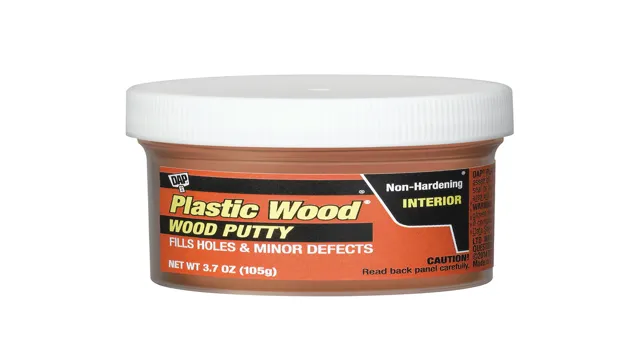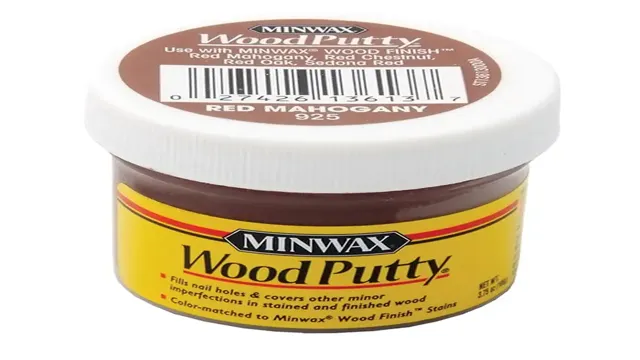Have you ever tried to paint over non-hardening wood putty, only to find that it peeled or cracked soon after? It’s a frustrating situation, but thankfully, there are solutions. Wood putty is great for filling in holes or gaps in wood surfaces, but it can be challenging to paint over. That’s because putty doesn’t always dry to a hard, sandable surface that paint can adhere to.
But don’t worry; you don’t have to start all over or give up on your DIY project because of painting over non-hardening wood putty. With the right techniques and materials, you can paint over it like a pro and achieve beautiful, long-lasting results. So, let’s discuss how to do that and get your project back on track.
Understanding Non-Hardening Wood Putty
If you’re looking to repair or cover up holes, gaps, or blemishes in wood, you might consider using non-hardening wood putty as a solution. But can you paint over it? The answer is yes! In fact, painting over non-hardening wood putty is a common practice as it creates a seamless finish. This type of putty remains workable and pliable, even after it dries, making it an excellent choice for DIY projects.
It’s easy to apply and is great for filling small joints or nail holes. However, keep in mind that non-hardening wood putty does not dry hard and can become yellow or brittle over time. If you’re looking for a putty that dries hard and can withstand weathering, it’s best to opt for a hardening version.
Nevertheless, non-hardening wood putty is still a valuable product that can offer quick results and a professional-looking finish.
Composition
Non-hardening wood putty is a popular choice for DIY woodworking projects, repairs, and restorations. It is a versatile solution that is easy to use and provides excellent results in filling gaps, cracks, and holes in wood surfaces. Non-hardening wood putty is made of a combination of materials such as wood fibers, resins, and oils, which give it a smooth consistency and make it easy to work with.
One of the most significant benefits of non-hardening wood putty is that it never dries, so you can mold and shape it to your desired form. This quality makes the non-hardening wood putty perfect for repairing antique furniture or restoring old frames. Additionally, it can be painted or stained to match the surrounding wood, giving your project a seamless, natural look.
So, if you’re looking for an easy-to-use and versatile solution for your woodworking needs, non-hardening wood putty is an excellent option to consider.

Uses
Non-hardening wood putty is one of the most versatile products in the woodworking industry. It is a type of filler that is used to cover up imperfections in wood surfaces, such as cracks, dents, and gouges. The unique feature of non-hardening wood putty is that it does not dry out or harden like other types of wood fillers.
This means that you can easily sand, stain, or paint directly over the putty without worrying about it cracking or flaking off. Non-hardening wood putty can be used on a wide variety of wood surfaces, including furniture, cabinetry, and flooring. It is an excellent choice for those who want a quick and easy fix for their woodworking projects, without the need for extensive sanding or re-staining.
Overall, non-hardening wood putty is a cost-effective and time-saving solution for any woodworking project, big or small.
Benefits and Drawbacks
Non-hardening wood putty is a popular material used by woodworkers to fill gaps and holes in wood surfaces. It is a pliable blend of wood fibers, binders, and oils that remain flexible even after it dries. There are many benefits of using non-hardening wood putty, such as its ability to be sanded, painted, and stained like real wood.
It’s perfect for repairing small dings and dents on furniture, floors, and woodworking projects. Non-hardening wood putty is also easy to work with and can be applied with a putty knife or your fingers. However, there are also some drawbacks to using this material.
For instance, it can become soft and sticky when exposed to heat or high humidity. It can also shrink or crack over time, especially if it’s applied too thinly. Nonetheless, non-hardening wood putty is an excellent choice for those who need to quickly fix minor imperfections in their woodworking projects.
Painting Over Non-Hardening Wood Putty
If you’ve used non-hardening wood putty to fill in gaps and holes in your woodwork, you may be wondering if you can paint over it. The short answer is yes, you can paint over non-hardening wood putty, but there are a few things to consider. First, make sure the putty is completely dry before you start painting.
If it’s not dry, it will not only affect the paint’s finish, but it can also cause the paint to peel or crack. Once the putty is dry, lightly sand the surface to ensure the paint adheres properly. It’s also a good idea to use a primer before applying your paint of choice.
This will ensure a smooth surface and help the paint adhere better. So, go ahead and paint over your non-hardening wood putty, but make sure it’s completely dry and sanded first for the best results.
Preparation Tips
When it comes to painting over non-hardening wood putty, preparation is key. Before you even think about picking up a paintbrush, make sure the surface is clean and sanded smooth. Any rough edges or debris can impact the final finish of your paint job.
Next, apply a coat of primer to the putty and surrounding area. This will ensure that your paint adheres properly and won’t peel or chip. If the putty is particularly thick or noticeable, consider using a high-build primer which will help to level out any imperfections.
Once your primer is dry, it’s time to paint. Be sure to use a paint that is suitable for the surface and conditions, such as indoor or outdoor use, and always apply a second coat for a durable, long-lasting finish. By taking the time to properly prepare your non-hardening wood putty for painting, you can achieve a flawless end result that will make your DIY project shine.
Painting Process
If you’re planning to paint over non-hardening wood putty, it’s crucial to take the right steps to ensure a smooth and even finish. To begin with, sand the surface of the putty with a fine-grit sandpaper to remove any bumps or unevenness. Next, wipe the area with a damp cloth to remove any dust or debris, and allow it to dry completely before starting to paint.
Using a high-quality primer is essential for achieving a long-lasting finish, and it can help the paint adhere better to the putty surface. Once the primer is fully dry, you can start painting with your chosen color. Be sure to use a high-quality paintbrush or roller to apply the paint evenly, and allow it to dry completely before adding a second coat if necessary.
By following these simple steps, you can ensure that your painted surface looks great and lasts for years to come.
Recommended Paints
When it comes to painting over non-hardening wood putty, not all paints are created equal. You’ll want to choose a high-quality paint that will adhere well to the putty and provide a smooth finish. Two recommended paints for this task are acrylic latex paint and oil-based paint.
Acrylic latex paint is a popular choice because it is easy to clean up with soap and water, dries quickly, and is resistant to cracking and peeling. Oil-based paint, on the other hand, provides a durable and long-lasting finish that is resistant to abrasion and fading. However, it takes longer to dry and requires solvents for clean-up.
Ultimately, the choice between these two paints will depend on your personal preferences and the specific needs of your project. Regardless of which paint you choose, be sure to follow the manufacturer’s instructions for application and drying time to ensure the best results.
Conclusion
In conclusion, the answer to the question “Can you paint over non hardening wood putty?” is a resounding “maybe.” While it may technically be possible to apply paint over non hardening putty, the results may not be satisfactory in terms of the durability and longevity of the finish. It’s always best to use a high-quality, hardening putty designed for woodworking projects if you want to ensure a smooth surface that can stand up to the test of time.
Otherwise, be prepared to touch up your paint job on a regular basis. As they say, a stitch in time saves nine – in this case, investing in the right materials upfront can save you a lot of headaches (and wasted time) down the line!”
FAQs
What is non hardening wood putty?
Non hardening wood putty is a type of wood filler that remains pliable and doesn’t dry or harden like traditional wood fillers.
Can you paint over non hardening wood putty?
Yes, you can paint over non hardening wood putty once it is dry. However, it may take longer to dry than traditional wood fillers.
How long does non hardening wood putty take to dry?
Non hardening wood putty can take anywhere from 24-72 hours to dry, depending on the thickness and humidity.
Can you sand non hardening wood putty?
Yes, you can sand non hardening wood putty once it is dry. However, it may be more difficult to sand than traditional wood fillers.
Is non hardening wood putty waterproof?
Non hardening wood putty is not entirely waterproof, but it can withstand some moisture since it remains pliable.
How can you remove non hardening wood putty?
Non hardening wood putty can be removed with a putty knife or sanded away. It may require more effort to remove than traditional wood fillers.
Can you stain non hardening wood putty?
Yes, you can stain non hardening wood putty once it is dry. However, it may not take stain evenly and may require additional coats.






